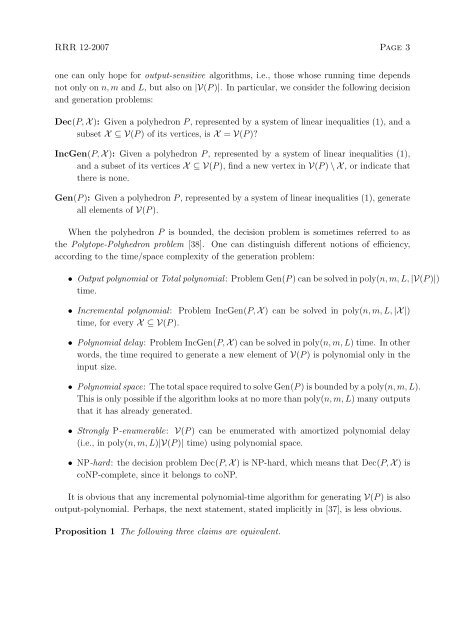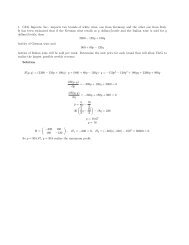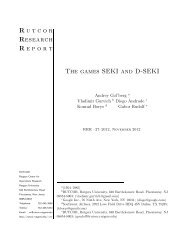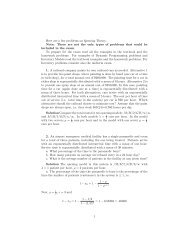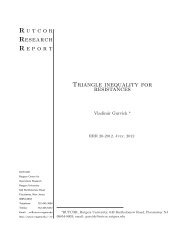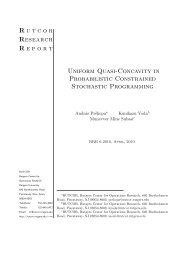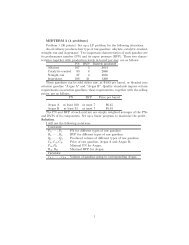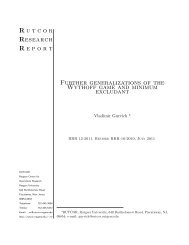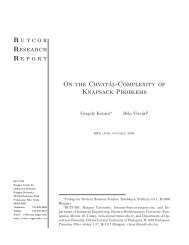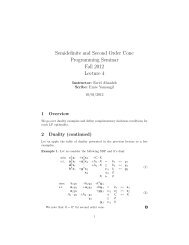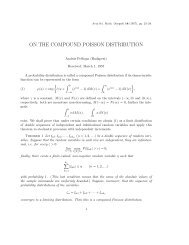Generating vertices of polyhedra and related monotone ... - Rutcor
Generating vertices of polyhedra and related monotone ... - Rutcor
Generating vertices of polyhedra and related monotone ... - Rutcor
You also want an ePaper? Increase the reach of your titles
YUMPU automatically turns print PDFs into web optimized ePapers that Google loves.
RRR 12-2007 Page 3one can only hope for output-sensitive algorithms, i.e., those whose running time dependsnot only on n,m <strong>and</strong> L, but also on |V(P)|. In particular, we consider the following decision<strong>and</strong> generation problems:Dec(P, X): Given a polyhedron P, represented by a system <strong>of</strong> linear inequalities (1), <strong>and</strong> asubset X ⊆ V(P) <strong>of</strong> its <strong>vertices</strong>, is X = V(P)?IncGen(P, X): Given a polyhedron P, represented by a system <strong>of</strong> linear inequalities (1),<strong>and</strong> a subset <strong>of</strong> its <strong>vertices</strong> X ⊆ V(P), find a new vertex in V(P) \ X, or indicate thatthere is none.Gen(P): Given a polyhedron P, represented by a system <strong>of</strong> linear inequalities (1), generateall elements <strong>of</strong> V(P).When the polyhedron P is bounded, the decision problem is sometimes referred to asthe Polytope-Polyhedron problem [38]. One can distinguish different notions <strong>of</strong> efficiency,according to the time/space complexity <strong>of</strong> the generation problem:• Output polynomial or Total polynomial: Problem Gen(P) can be solved in poly(n,m,L, |V(P)|)time.• Incremental polynomial: Problem IncGen(P, X) can be solved in poly(n,m,L, |X |)time, for every X ⊆ V(P).• Polynomial delay: Problem IncGen(P, X) can be solved in poly(n,m,L) time. In otherwords, the time required to generate a new element <strong>of</strong> V(P) is polynomial only in theinput size.• Polynomial space: The total space required to solve Gen(P) is bounded by a poly(n,m,L).This is only possible if the algorithm looks at no more than poly(n,m,L) many outputsthat it has already generated.• Strongly P-enumerable: V(P) can be enumerated with amortized polynomial delay(i.e., in poly(n,m,L)|V(P)| time) using polynomial space.• NP-hard: the decision problem Dec(P, X) is NP-hard, which means that Dec(P, X) iscoNP-complete, since it belongs to coNP.It is obvious that any incremental polynomial-time algorithm for generating V(P) is alsooutput-polynomial. Perhaps, the next statement, stated implicitly in [37], is less obvious.Proposition 1 The following three claims are equivalent.


